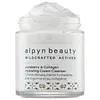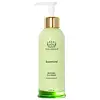What's inside
What's inside
 Key Ingredients
Key Ingredients

 Benefits
Benefits

 Concerns
Concerns

 Ingredients Side-by-side
Ingredients Side-by-side

Water
Skin ConditioningHelianthus Annuus Seed Oil
EmollientCetyl Alcohol
EmollientGlycerin
HumectantCetearyl Alcohol
EmollientCetearyl Olivate
Sorbitan Olivate
EmulsifyingTheobroma Cacao Seed Butter
EmollientPropanediol
SolventKaolin
AbrasiveDecyl Glucoside
CleansingBakuchiol
AntimicrobialCollagen
MoisturisingJojoba Esters
EmollientAmelanchier Alnifolia Fruit Extract
Skin ConditioningSclerotium Gum
Emulsion StabilisingCetearyl Glucoside
EmulsifyingCaprylyl Glycol
Emollient1,2-Hexanediol
Skin ConditioningSodium Lauroyl Sarcosinate
CleansingAcacia Senegal Gum
MaskingXanthan Gum
EmulsifyingCitric Acid
BufferingEucalyptus Globulus Leaf Oil
PerfumingTremella Fuciformis Polysaccharide
Emulsion StabilisingSalicylic Acid
MaskingMenthol
MaskingSimmondsia Chinensis Seed Oil
EmollientGlucose
HumectantIron Oxides
CI 77491
Cosmetic ColorantCaprylic/Capric Triglyceride
Masking3-O-Ethyl Ascorbic Acid
Skin ConditioningPistacia Lentiscus Gum
MaskingHydrogenated Lecithin
EmulsifyingPhenethyl Alcohol
MaskingEthylhexylglycerin
Skin ConditioningWater, Helianthus Annuus Seed Oil, Cetyl Alcohol, Glycerin, Cetearyl Alcohol, Cetearyl Olivate, Sorbitan Olivate, Theobroma Cacao Seed Butter, Propanediol, Kaolin, Decyl Glucoside, Bakuchiol, Collagen, Jojoba Esters, Amelanchier Alnifolia Fruit Extract, Sclerotium Gum, Cetearyl Glucoside, Caprylyl Glycol, 1,2-Hexanediol, Sodium Lauroyl Sarcosinate, Acacia Senegal Gum, Xanthan Gum, Citric Acid, Eucalyptus Globulus Leaf Oil, Tremella Fuciformis Polysaccharide, Salicylic Acid, Menthol, Simmondsia Chinensis Seed Oil, Glucose, Iron Oxides, CI 77491, Caprylic/Capric Triglyceride, 3-O-Ethyl Ascorbic Acid, Pistacia Lentiscus Gum, Hydrogenated Lecithin, Phenethyl Alcohol, Ethylhexylglycerin
Calendula Officinalis Flower/Leaf/Stem Juice
Skin ConditioningDecyl Glucoside
CleansingPropanediol
SolventShea Butter Glycerides
EmulsifyingCetearyl Olivate
Oryza Sativa Powder
Sodium Lauroyl Lactylate
EmulsifyingDiglycerin
HumectantLactobacillus Ferment
Skin ConditioningLeuconostoc Ferment Filtrate
AntimicrobialWater
Skin ConditioningSorbitan Olivate
EmulsifyingVaccinium Macrocarpon Fruit Extract
AstringentGlycerin
HumectantGlycolipids
Skin ConditioningCentella Asiatica Extract
CleansingSaccharide Isomerate
HumectantRicinus Communis Seed Oil
MaskingPinus Sylvestris Leaf Extract
TonicOenothera Biennis Oil
EmollientPyrus Malus Seed Oil
EmollientSimmondsia Chinensis Seed Oil
EmollientSqualane
EmollientVitis Vinifera Seed Oil
EmollientBorago Officinalis Leaf Extract
Skin ConditioningCalendula Officinalis Flower Extract
MaskingChamomilla Recutita Flower Extract
MaskingLavandula Angustifolia Extract
Skin ConditioningMedicago Sativa Extract
TonicLactic Acid
BufferingSclerotium Gum
Emulsion StabilisingHelianthus Annuus Seed Oil
EmollientPhytic Acid
Sodium Hydroxide
BufferingCitric Acid
BufferingSodium Citrate
BufferingCalendula Officinalis Flower/Leaf/Stem Juice, Decyl Glucoside, Propanediol, Shea Butter Glycerides, Cetearyl Olivate, Oryza Sativa Powder, Sodium Lauroyl Lactylate, Diglycerin, Lactobacillus Ferment, Leuconostoc Ferment Filtrate, Water, Sorbitan Olivate, Vaccinium Macrocarpon Fruit Extract, Glycerin, Glycolipids, Centella Asiatica Extract, Saccharide Isomerate, Ricinus Communis Seed Oil, Pinus Sylvestris Leaf Extract, Oenothera Biennis Oil, Pyrus Malus Seed Oil, Simmondsia Chinensis Seed Oil, Squalane, Vitis Vinifera Seed Oil, Borago Officinalis Leaf Extract, Calendula Officinalis Flower Extract, Chamomilla Recutita Flower Extract, Lavandula Angustifolia Extract, Medicago Sativa Extract, Lactic Acid, Sclerotium Gum, Helianthus Annuus Seed Oil, Phytic Acid, Sodium Hydroxide, Citric Acid, Sodium Citrate
Ingredients Explained
These ingredients are found in both products.
Ingredients higher up in an ingredient list are typically present in a larger amount.
Cetearyl Olivate is an emulsifier and texture enhancer. It is derived from the fatty acids of olive oil and Cetearyl alcohol, and is biodegradable.
As an emulsifier, it is used to prevent oils and waters from separating. It can also
Manufacturers use the name Olivem 1000. This ingredient has been found to preserve the natural microbiome of skin. Having a healthy microbiome helps keep our skin healthy and protects against harmful bacteria. This ingredient is grouped with Sorbitan Olivate under the name Olivem 1000.
Learn more about Cetearyl OlivateCitric Acid is an alpha hydroxy acid (AHA) naturally found in citrus fruits like oranges, lemons, and limes.
Like other AHAs, citric acid can exfoliate skin by breaking down the bonds that hold dead skin cells together. This helps reveal smoother and brighter skin underneath.
However, this exfoliating effect only happens at high concentrations (20%) which can be hard to find in cosmetic products.
Due to this, citric acid is usually included in small amounts as a pH adjuster. This helps keep products slightly more acidic and compatible with skin's natural pH.
In skincare formulas, citric acid can:
While it can provide some skin benefits, research shows lactic acid and glycolic acid are generally more effective and less irritating exfoliants.
Most citric acid used in skincare today is made by fermenting sugars (usually from molasses). This synthetic version is identical to the natural citrus form but easier to stabilize and use in formulations.
Read more about some other popular AHA's here:
Learn more about Citric AcidDecyl Glucoside is a glucose-based surfactant and emulsion stabilizer. It is created by reacting glucose with the fatty acids from plants.
Surfactants help clean the skin by trapping oil, sebum, and dirt to be washed away. As an emulsion stabilizer, it stabilizes the ingredients in a product by preventing them from separating.
This ingredient is biodegradable and non-toxic. This ingredient is commonly found in baby shampoos.
Decyl Glucoside is sometimes used to stabilize the UV filter Tinosorb.
Learn more about Decyl GlucosideGlycerin is already naturally found in your skin. It helps moisturize and protect your skin.
A study from 2016 found glycerin to be more effective as a humectant than AHAs and hyaluronic acid.
As a humectant, it helps the skin stay hydrated by pulling moisture to your skin. The low molecular weight of glycerin allows it to pull moisture into the deeper layers of your skin.
Hydrated skin improves your skin barrier; Your skin barrier helps protect against irritants and bacteria.
Glycerin has also been found to have antimicrobial and antiviral properties. Due to these properties, glycerin is often used in wound and burn treatments.
In cosmetics, glycerin is usually derived from plants such as soybean or palm. However, it can also be sourced from animals, such as tallow or animal fat.
This ingredient is organic, colorless, odorless, and non-toxic.
Glycerin is the name for this ingredient in American English. British English uses Glycerol/Glycerine.
Learn more about GlycerinHelianthus Annuus Seed Oil is the oil derived from the seeds of a Sunflower. Sunflower seed oil is non-fragrant. It is an emollient, meaning it helps to soften the skin.
Sunflower seed oil contains many fatty acids. The fatty acids found in sunflower seeds include (from highest amount to least): linoleic acid, myristic acid, palmitic acid, stearic acid, arachidic acid, oleic acid, and linolenic acid.
These fatty acids help the skin create ceramides. Ceramides play a role in repairing the skin barrier.
Helianthus Annuus Seed Oil helps moisturize the skin. This in turn helps the skin look more rejuvenated and smoother.
Sunflowers are rich in vitamin E.
Historians believe Indigenous cultures of North America domesticated sunflowers before corn. Thus they relied on sunflower oil for a variety of uses. One such use is moisturizing skin and hair.
Sunflower seed oil may not be fungal acne safe. We recommend speaking with a professional if you have any concerns.
Learn more about Helianthus Annuus Seed OilPropanediol is an all-star ingredient. It softens, hydrates, and smooths the skin.
It’s often used to:
Propanediol is not likely to cause sensitivity and considered safe to use. It is derived from corn or petroleum with a clear color and no scent.
Learn more about PropanediolSclerotium Gum is a polysaccharide gum made by the fungus, Sclerotium rolfssii. It is similar to xanthan gum.
In cosmetics, Sclerotium Gum is used to thicken the texture and to help stabilize other ingredients.
As an emulsifier, Sclerotium Gum helps prevent ingredients from separating, such as water and oil.
Learn more about Sclerotium GumThis oil comes from the seeds of the desert shrub called Jojoba. It is more commonly known as jojoba oil, a non-comedogenic oil.
Jojoba oil does not contain fragrance and has many fatty-acids, making it a great soothing ingredient.
It also contains Vitamin E, a great moisturizing ingredient. Vitamin E is also an antioxidant and protects your skin against oxidative damage.
This ingredient humectant properties, meaning it helps draw moisture from the air. This helps keep your skin hydrated.
While jojoba has antibacterial properties, it is only able to kill some strains of bacteria.
Studies also show it helps in wound healing. In fact, Indigenous cultures have used jojoba as a moisturizer and to help treat burns for centuries.
Fun fact: Jojoba oil similar to natural human skin sebum, so it has a great effect on dry skin. It is also promising with helping to regulate sebum production.
Due to its fatty acid content, Jojoba oil may not be fungal acne safe. We recommend speaking with a professional if you have any concerns.
Learn more about Simmondsia Chinensis Seed OilSorbitan Olivate is created from the fatty acids in olive oil and sorbitol.
This ingredient is an oil in water emulsifier. It helps stabilize a product by preventing oils and waters from separating. Sorbitan Olivate also helps hydrate the skin.
Manufacturers sell sorbitan olivate under the name OliveM 1000. OliveM 1000 a multifunctional ingredient. It is self-emulsifying. According to a manufacturer, OliveM 1000 does not disrupt natural skin biome.
Due to its olive oil base, this ingredient may not be fungal-acne safe.
Learn more about Sorbitan OlivateWater. It's the most common cosmetic ingredient of all. You'll usually see it at the top of ingredient lists, meaning that it makes up the largest part of the product.
So why is it so popular? Water most often acts as a solvent - this means that it helps dissolve other ingredients into the formulation.
You'll also recognize water as that liquid we all need to stay alive. If you see this, drink a glass of water. Stay hydrated!
Learn more about Water